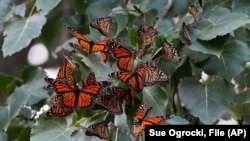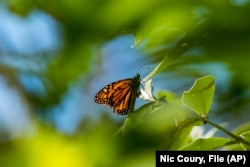An American nonprofit group says the number of monarch butterflies spending the winter in the western United States has dropped to its second-lowest mark in nearly 30 years.
The Xerces Society for Invertebrate Conservation, based in Oregon, said the causes for this include the use of chemicals to kill insects, known as pesticides. The group also blames reductions in habitat and climate change.
The survey began in 1997
Monarch butterflies are known for their clear orange-and-black markings. They live across North America. Monarchs in the eastern United States spend the winter in Mexico. The World Wildlife Fund, a non-profit based in Switzerland, counts them there but has not yet released data for this year. Monarchs west of the Rocky Mountains usually spend the winter along the California coast.
The Xerces Society for Invertebrate Conservation has been counting western overwinter populations in California and Arizona for the last 28 years. The highest number recorded was 1.2 million in 1997. The organization announced Friday that it counted just 9,119 monarchs in 2024, a decrease of 96 percent from 233,394 in 2023. The total was the second lowest since the survey began in 1997. The record-low count was 1,901 monarchs in 2020.
The survey noted that a place in Santa Barbara that saw 33,200 monarchs last winter had only 198 butterflies this year.
Heat might have hurt western monarchs
Monarchs across North America face increasing threats. One is the supply of a plant, milkweed, which they feed on as caterpillars. Monarch Joint Venture is a nonprofit group based in Minnesota that aims to protect monarchs. The group said milkweed has been disappearing because of dry weather, wildfires, agriculture and urban development. The Xerces Society said pesticides might be on the remaining plants.
Emma Pelton is a biologist with the Xerces Society. She said it is unclear what caused such a sharp decrease in the western population in just one year. The monarch population is already small, she said, and heat above 37.7 degrees Celsius in the western states last year might have slowed breeding.
Monarchs suffer when the temperature gets up to 37.7 degrees Celsius and any temperatures above 42.2 degrees Celsius will kill the insects, Pelton said.
The western states saw a heat wave in July with temperatures in some areas well past 37.7 degrees. Palm Springs, for example, reportedly reached a record 51.1 degrees Celsius on July 5. Another heat wave hit northern California in early October, with several cities breaking heat records.
Western monarchs' future unclear
Pelton said that it is too early to tell what long-term effect the sharp drop might have on the overall western monarch population. Insects can reproduce very quickly, Pelton said. After a low point of 1,901 butterflies in 2020, the population recovered to 247,246 insects the following year, an increase of nearly 13,000 percent. The year after that the survey recorded 335,479 monarchs.
"This is bad news," Pelton said of the 2024 population drop. "But we have seen incredible recovery. This doesn't mean we're not going to have western monarchs.”
Federal officials working on protections
The U.S. Fish and Wildlife Service announced in December 2024 that it wanted to list monarchs as threatened. Such a move would ban people from killing or transporting them. The proposed change would also ban property owners from making changes to their property that would make it unusable to the butterflies. For example, removing all milkweed from a property would by banned by law.
Earthjustice is an environmental nonprofit legal group based in San Francisco. It asked the Environmental Protection Agency in December 2024 to require testing of pesticides’ effects on insects such as bees, moths and butterflies.
I’m Jill Robbins.
Todd Richmond reported this story for the Associated Press. Jill Robbins adapted it for Learning English.
____________________________________________________
Words in This Story
pesticide – n. a chemical that is used to kill animals or insects that damage plants or crops
habitat –n. the place or environment where a living thing lives
survey –n. a study of a subject aimed at finding something out
caterpillar –n. an early stage in the life of certain insects
breed – v. to produce young animals, birds, or the like
What do you think of this story? Write to us in the Comments Section.














Forum